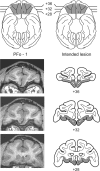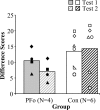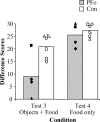Bilateral orbital prefrontal cortex lesions in rhesus monkeys disrupt choices guided by both reward value and reward contingency
- PMID: 15329401
- PMCID: PMC6729636
- DOI: 10.1523/JNEUROSCI.1921-04.2004
Bilateral orbital prefrontal cortex lesions in rhesus monkeys disrupt choices guided by both reward value and reward contingency
Abstract
The orbital prefrontal cortex (PFo) operates as part of a network involved in reward-based learning and goal-directed behavior. To test whether the PFo is necessary for guiding behavior based on the value of expected reward outcomes, we compared four rhesus monkeys with two-stage bilateral PFo removals and six unoperated controls for their responses to reinforcer devaluation, a task that assesses the monkeys' abilities to alter choices of objects when the value of the underlying food has changed. For comparison, the same monkeys were tested on a standard test of flexible stimulus-reward learning, namely object reversal learning. Relative to controls, monkeys with bilateral PFo removals showed a significant attenuation of reinforcer devaluation effects on each of two separate assessments, one performed shortly after surgery and the other approximately 19 months after surgery; the operated monkeys were also impaired on object reversal learning. The same monkeys, however, were unimpaired in acquisition of object discrimination learning problems and responded like controls when allowed to choose foods alone, either on a food preference test among six different foods or after selective satiation. Thus, satiety mechanisms and the ability to assign value to familiar foods appear to be intact in monkeys with PFo lesions. The pattern of results suggests that the PFo is critical for response selection based on predicted reward outcomes, regardless of whether the value of the outcome is predicted by affective signals (reinforcer devaluation) or by visual signals conveying reward contingency (object reversal learning).
Figures






Similar articles
-
Combined unilateral lesions of the amygdala and orbital prefrontal cortex impair affective processing in rhesus monkeys.J Neurophysiol. 2004 May;91(5):2023-39. doi: 10.1152/jn.00968.2003. Epub 2004 Jan 7. J Neurophysiol. 2004. PMID: 14711973
-
Rhesus monkeys with orbital prefrontal cortex lesions can learn to inhibit prepotent responses in the reversed reward contingency task.Cereb Cortex. 2007 May;17(5):1154-9. doi: 10.1093/cercor/bhl025. Epub 2006 Jun 14. Cereb Cortex. 2007. PMID: 16774961
-
Differential effects of amygdala, orbital prefrontal cortex, and prelimbic cortex lesions on goal-directed behavior in rhesus macaques.J Neurosci. 2013 Feb 20;33(8):3380-9. doi: 10.1523/JNEUROSCI.4374-12.2013. J Neurosci. 2013. PMID: 23426666 Free PMC article.
-
Interactions between orbital prefrontal cortex and amygdala: advanced cognition, learned responses and instinctive behaviors.Curr Opin Neurobiol. 2010 Apr;20(2):212-20. doi: 10.1016/j.conb.2010.02.001. Epub 2010 Feb 22. Curr Opin Neurobiol. 2010. PMID: 20181474 Free PMC article. Review.
-
Behavioral outcomes of late-onset or early-onset orbital frontal cortex (areas 11/13) lesions in rhesus monkeys.Ann N Y Acad Sci. 2011 Dec;1239:71-86. doi: 10.1111/j.1749-6632.2011.06211.x. Ann N Y Acad Sci. 2011. PMID: 22145877 Free PMC article. Review.
Cited by
-
Transient and Persistent Representations of Odor Value in Prefrontal Cortex.Neuron. 2020 Oct 14;108(1):209-224.e6. doi: 10.1016/j.neuron.2020.07.033. Epub 2020 Aug 21. Neuron. 2020. PMID: 32827456 Free PMC article.
-
Transient inactivation of basolateral amygdala during selective satiation disrupts reinforcer devaluation in rats.Behav Neurosci. 2012 Aug;126(4):563-74. doi: 10.1037/a0029080. Behav Neurosci. 2012. PMID: 22845705 Free PMC article.
-
Piecing together the orbitofrontal puzzle.Behav Neurosci. 2021 Apr;135(2):301-311. doi: 10.1037/bne0000466. Behav Neurosci. 2021. PMID: 34060882 Free PMC article.
-
The signal attenuation rat model of obsessive-compulsive disorder: a review.Psychopharmacology (Berl). 2006 Jul;186(4):487-503. doi: 10.1007/s00213-006-0387-2. Psychopharmacology (Berl). 2006. PMID: 16718482 Review.
-
Aging affects acquisition and reversal of reward-based associative learning.Learn Mem. 2008 Mar 19;15(4):190-7. doi: 10.1101/lm.890408. Print 2008 Apr. Learn Mem. 2008. PMID: 18353994 Free PMC article.
References
-
- Balleine BW (2001) Incentive processes in instrumental conditioning. In: Handbook of contemporary learning theories (Mowrer RR, Klein SB, eds), pp 307-366. Mahwah, NJ: Erlbaum.
-
- Baylis LL, Gaffan D (1991) Amygdalectomy and ventromedial prefrontal ablation produce similar deficits in food choice and in simple object discrimination learning for an unseen reward. Exp Brain Res 86: 617-622. - PubMed
-
- Bussey TJ, Wise SP, Murray EA (2001) The role of ventral and orbital prefrontal cortex in conditional visuomotor learning and strategy use in rhesus monkeys (Macaca mulatta). Behav Neurosci 115: 971-982. - PubMed
-
- Bussey TJ, Wise SP, Murray EA (2002) Interaction of ventral and orbital prefrontal cortex with inferotemporal cortex in conditional visuomotor learning. Behav Neurosci 116: 703-715. - PubMed
Publication types
MeSH terms
LinkOut - more resources
Full Text Sources
